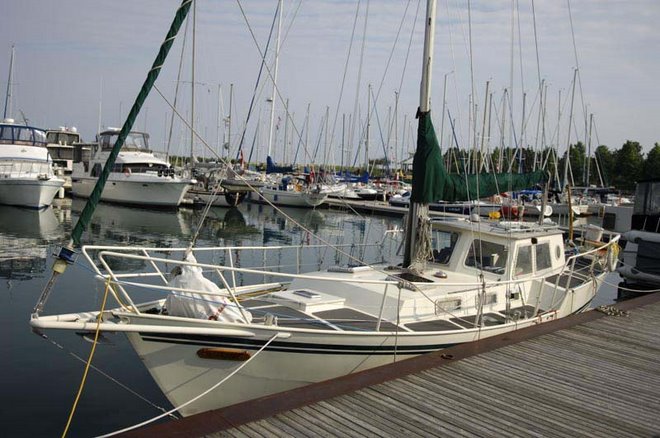 |
| Still to replace: the cracked shut-off hose under the actual sink. It's complex down there. |
Behold the (mostly) completed new galley drain. That four-piece AWAB opposing hose-clamp set-up is the apotheosis of belt-and-suspenders sailing, given that it's a ridiculously short piece of hose...but then I was the one who specified a taller pipe nipple, meaning the PVC elbow and the nipple on the Marelon ball valve very nearly meet in the middle. Oh, well. It didn't leak from there on the day.
 |
| Still life with bicycle and boat. Yeah, she's a bit hefty, that boat. |
The day in question was Saturday, April 28th, cool, windy and frequently rainy. Sub-par in most respects, save that a big push from Mrs.
Alchemy (painting a specialt) and myself (wrenching the same) got the job(s) done.
The bottom paint this year was once again Pettit, but of a delightful Hunter Green not unlike the cove stripe (which also got touched up by my fastidious co-skipper. Next year, we grind back to the bare metal in Nova Scotia, but that's a future post.
 |
| The new outlet for the head drain is behind the redone caulking for the forward-looking sonar. |
There was a little bit of water ingress from the depth transducer last year, so Mrs. Alchemy took charge of "
dissolving the old 5200", a stinky and labourious process, and applying "
fast cure". She was more careful inside and out than was possible with last year's
rushed (and bloody) process, and nothing is leaking as of yesterday's dockside inspection.
 |
| "Fire Escape", owned by a fire chief, naturally. |
Unlike previous launch days, the crane position dictated we were to go in quite early, as the second boat in the east yard, shortly after 7 AM. It was calm, however, and not yet raining...
 |
| The "sling crews" step from boat to boat to do their work. |
 |
| That fibreglass hull needs a touch more TLC than ours. |
The front row of what we call "The Inner Basin" is full of alarmingly large powerboats:
Alchemy is far from being big in such company, although at about 15 tonnes, we are not insignificant.
 |
| Sling marks obtained! |
 |
| The head of hair belongs to the owner of the next boat after us. |
Note the "cinch belts" holding the slings in place. This keep the slings from "creeping" up the slope of the keel, as I am never sure if my moving things about in the boat all winter has altered the ideal place on which to put the slings in terms of a level hoist.
 |
| People never fail to take a step back at this stage. Note the nice job done on the keel bottom. That plate is 3/4" thick. |
 |
| You can never have too many fenders for this gig. |
The lift this year was quick and efficient; compared to the more methodical haulout process, launch is usually faster.
 |
| Putting pennants on moorings in better weather earlier in the week. At launch, it was too wet and busy for photos! |
After docking, however, I was crewing on the club workboat and we had the highest number of "splashed with dead motor" cases I can recall...so it was a very busy morning on that boat.
 |
| Maybe I should shift the sling marks aft a little bit? |
Long morning story short, the engine fired instantly (I had done a static test in the cradle the previous day) and we docked without further incident, although there was slight leaking beneath the new Marelon ball valves that needed a bit of tape to cure, no pun intended. I may have to spin them off next fall and be more generous with the pipe dope. As of yesterday, however, the damp has been banished. We will monitor for further issues. The dual exhaust is also, gratifyingly, dual exhausting, and the engine "note" is slightly changed, suggesting that there is, in fact, reduced back pressure.
 |
| The benefits of being (nearly) first in is getting an unobstructed beauty shot. |
Next up:
Manifesting the radar love and readying the mast with new VHF and AIS runs.












































